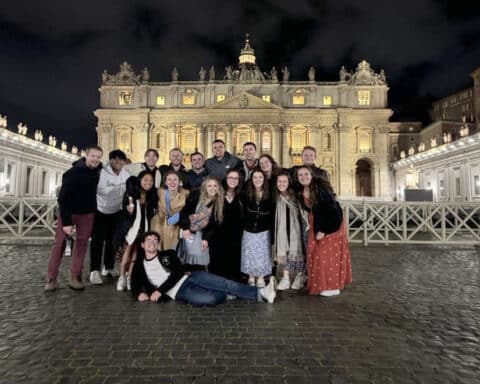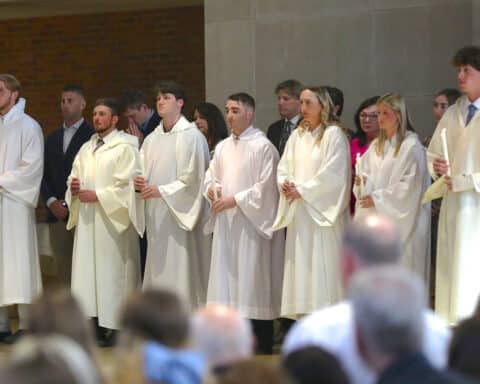The Supreme Court’s ruling that the use of race in college admissions violates the equal protection clause of the U.S. Constitution triggered a common reaction on the part of university and college presidents across the nation. The emails that sprung forth almost instantaneously expressed, on the one hand, “disappointment” with the decision and, on the other, a continuing commitment to building evermore diverse and inclusive campuses.
Leaders of Catholic schools often added the demands of Catholic social teaching and the need for their campuses to reflect the diversity of the Church. The common sentiment of these messages was that while the court had taken away an important tool for uplifting certain applicants over others, the practice would nevertheless proceed by intensifying or developing strategies untouched by the ruling. Harvard University, for example, claimed to have found a workaround in the wording of the majority opinion that applicants will be able to present “how race affected his or her life, be it through discrimination, inspiration, or otherwise.”
Since a major part of the case was Harvard’s discrimination against Asians in favor of African American and Hispanic aspirants, the implication seems to be that the narratives of Asian applicants would be less compelling. Why exactly this would be the case was not explained. Here we see the tragedy of affirmation action: The desire to help one racial group requires hurting the prospects of another. Admission to selective schools is, alas, a zero-sum game: One student gets in because another student does not.
An ongoing effort
It is too soon to predict the consequences of ending affirmative action, but we can be sure that Catholic schools will continue to do what they can to ensure that disadvantaged students have a chance to attend. Catholic higher education has a long and proud history of providing the children of immigrants and marginalized groups access to the middle class. As one group gained greater social and economic success, the need shifted to newer arrivals. While the first-generation students of 60 years ago were often Irish, Polish or Italian, they now typically come from Hispanic families. Given the racial history of our country, Catholic schools have for many decades reached out to African Americans, as well.
The Supreme Court’s ruling will not halt these efforts even if the chances of certain students will no longer be enhanced (or harmed) by their race or ethnicity. The most common suggestion for an alternative to race — and the one most consonant with Catholic social teaching — is economic status. Nothing prevents schools from replacing “race-conscious admissions” with one that considers the socio-economic status of applying students. Professors know from experience that, with very few exceptions, high schools from wealthier zip codes better prepare their students for college work. Since rates of poverty in the United States are higher among Blacks and Hispanics than whites and Asians, it is likely that this strategy would yield a diverse student body provided it was complimented by need-blind admissions and well-directed financial aid.
Diversity, equity and inclusion
If this is the case, what explains the public anxiety coming from the leaders of Catholic higher education at no longer being able to use race in admissions? Why the desire to keep race front and center?
I suspect it is connected to the place diversity, equity and inclusion (DEI) has recently taken in our schools. A movement that goes back to the 1960s as a way for corporations to conduct “diversity training” for their employees, DEI has now become a billion-dollar industry with influence in virtually every aspect of American life. This growth has been accompanied by a radicalization of ideology, as the goal went from enabling harmonious race relations in the workplace to exposing and overcoming structures of anti-Black racism and white supremacy.
Numerous studies have shown that such efforts often make the situation worse, creating new racial animosities and resentments where none existed. Far from building community across differences, DEI more often exacerbates those differences. This dubious record has not, however, prevented colleges and universities from establishing DEI offices and giving them outsized influence over hiring, academic assessments and even curriculum. In too many Catholic schools, the goals of DEI, along with its ideology, have supplanted their religious mission or been conflated with it. Perhaps the court’s rejection of affirmation action in admissions might provide an opportunity to rethink the proper relationship of Catholic identity and DEI. Let me offer a few ideas toward reform.
Suggestions for reform
The first is that the mystery of God revealed in Jesus Christ provides the only reliable path toward authentic community between individuals of different backgrounds. In the eyes of God, we are all sinners who, apart from grace, deserve judgment. We have no basis, therefore, for placing ourselves above others. Rather, each of us is called, in the words of St. Paul, to “humbly regard others as more important than ourselves” (Phil 2:3).
This admonition is not specific to any race or ethnicity but intended equally for all. As Aleksandr Solzhenitsyn puts it, “The line separating good and evil passes not through states, nor between classes, nor between political parties, either — but right through every human heart.” It is our need for God’s unmerited love that allows sinful human beings to live together in fellowship.
At the same time, Catholics are called to imitate Jesus’ special attention to the most vulnerable. Catholic colleges and universities have a responsibility to pay special attention to those students brought into predominantly white and economically privileged student bodies in the cause of diversity. Although very few of our students are racists, they might well be obtuse about matters of money and social status. A good deal of harm can be done without intending to do so.
It makes good sense, therefore, to hire people with expertise in these matters, as well as establish certain policies and training programs. What must never be done, however, is to embrace an ideology that sets students against one another because of their race, explains all disparity by structural racism or downgrades all accomplishments on the part of white students as manifestations of privilege.
Most of all, the Marxist-inspired ideology of the DEI industry must never be permitted to undercut the only good reason Catholic schools exist at all: the opportunity to shape young minds in the accumulated wisdom of the Catholic intellectual tradition. The Supreme Court’s ruling, therefore, is an opportunity to reassert a Catholic understanding of how one builds a campus community that is inclusive and informed by charity.





